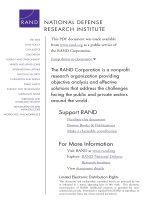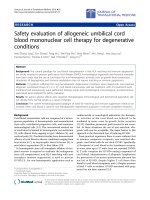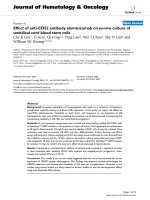Study the application of public cord blood stem cell transplantation for Leukemia treatment (from 10-2016 to 9-2018)
Bạn đang xem bản rút gọn của tài liệu. Xem và tải ngay bản đầy đủ của tài liệu tại đây (126.43 KB, 8 trang )
Journal of military pharmaco-medicine no1-2019
STUDY THE APPLICATION OF PUBLIC CORD BLOOD
STEM CELL TRANSPLANTATION FOR LEUKEMIA TREATMENT
(FROM 10 - 2016 TO 9 - 2018)
Bach Quoc Khanh1; Tran Ngoc Que1; Nguyen Ba Khanh1,2; Vo Thi Thanh Binh1
Dang Thi Thu Hang2; Nguyen Vu Bao Anh1,2; Nguyen Tuan Tung3
Kieu Thi Van Oanh3; Vu Duy Hong1; Duong Quoc Chinh1
Hoang Thi Thanh Nga1; Nguyen Anh Tri1
SUMMARY
Objectives: To describe the quality of cord blood stem cell stored in Stem Cell Bank of
National Institute of Hematology and Blood Transfusion, to assess the initial results of cord
blood transplantation for acute leukemia treatment. Subjects and method: Interventional,
retrospective and prospective study. Subjects included 3,466 public cord blood units which were
successfully stored, 05 patients with acute leukemia, transplanted by cord blood stem cell, in
National Institute of Hematology and Blood Transfusion, from October of 2016 to September of
2018. Results: After 02 years of following up, among 3,466 stored public cord blood units, the
7
5
mean total nucleated cell was 130.4 ± 41.9 x 10 , the mean CD34 cell was 45.9 ± 35.5 x 10 ,
the post-thawed viability of stem cells was 84.7 ± 3.4%; there were 30 acute leukemia patients
who were indicated for stem cell searching in public cord blood bank and the rate of successful
search was 97.7%; 05 patients were transplanted using the matched stem cell units; among that,
02 patients achieved stable engraftment; the most common complications were mucosal
ulceration (100%), bacteremia (100%) and CMV reactivation (100%); graft versus host disease
happened in 01 case; 03 mortality cases were all due to severe sepsis. Conclusion: Allogeneic
cord blood transplantation is a promising and effective method for the treatment of acute leukemia.
* Keywords: Acute leukemia; Allogeneic; Stem cell transplantation; Cord blood; Stem cell.
INTRODUCTION
Acute leukemia is one of the most
malignant hematological diseases with
very high mortality if treated by standard
chemotherapy. Today, thanks to allogeneic
stem cell transplantation, many acute
leukemia patients have been cured and
have long and stable lives. The most
common source of stem cell for
transplantation is from related donors
which is only available for about 30% of
patients. One of the effective alternative
source for transplantation patients without
related donors is public cord blood.
1. National Institute of Hematology and Blood Transfusion
2. Hanoi Medical University
3. Bachmai Hospital
Corresponding author: Tran Ngoc Que ()
Date received: 20/10/2018
Date accepted: 02/12/2018
52
Journal of military pharmaco-medicine no1-2019
Cord blood stem cell transplantation has
been applied in many developed countries
for the last 30 years with many achievements
[1]. Cord blood stem cell has also been
established at National Institute of
Hematology and Blood Transfusion
(NIHBT) since 2014. At this time, about
4,000 cord blood units have been stored
for transplantation purpose, in addition to
the routine source from related donors [2].
Beside stem cell creation, it is very important
to apply and assess the results of stem
cell transplantation for the treatment of
acute leukemia. This may help to prove
the cord blood quality and to encourage
and to improve this kind of stem cell source.
So, we conducted this study with the
objectives:
- To describe the quality of cord blood
stem cell sample/units stored in Stem Cell
Bank of NIHBT.
- To assess the initial results of cord
blood transplantation for acute leukemia
treatment.
SUBJECTS AND METHODS
1. Subjects.
- 3,466 cord blood units which were
collected, processed and cryopreserved
in Stem Cell Bank of NIHBT.
- 30 acute leukemia patients were
indicated for stem cell searching, in which
05 acute myeloid leukemia patients were
allogeneic transplanted using cord blood,
in Stem cell Transplantation Department
of NIHBT.
* Study time: From October of 2016 to
September of 2018.
2. Methods.
- Study design: Interventional, retrospective
and prospective study.
- Convenient sampling.
- Criteria for cord blood collection,
processing and storage: Healthy mothers
and infants without chronic or hereditary
diseases; the collected cord blood volume
was ≥ 80 mL, no abnormal colour, no
blood clot, no infection; the total nucleated
cell was ≥ 1,000 x 106, MCV ≥ 95 fl; the
stored units were negative with bacteria,
fungus, common virus and abnormal
hemoglobin components.
- Patient eligibility criteria: Patients
with acute leukemia (both myeloid and
lymphoblastic types), never transplanted
before, achieved complete remission at
time of transplantation, stable health status
without any acute diseases or disorders
(renal, liver or heart failure, severe infection…),
unable to find any HLA (human leukocyte
antigen)-matched related donors in their
families.
- Cord blood selection criteria: From
the public cord blood bank of NIHBT, HLA
matched at least 4/6 locus HLA-A, -B and
-DR at high resolution, the minimal dose
of total nuclear cells was 2 x 107 cells/kg,
the minimal dose of CD34+ cells was 0.8
x 105 cells/kg, no risk of impact by antiHLA antibodies in patient’s serum.
- Exclusion criteria: Patients with chronic
leukemia, other hematological diseases,
cord blood units unmet the selection criteria.
- Materials and equipment: Patient blood
samples, cord blood sample, FC500 flow
cytometer, automated cell count system
DXH500, Luminex system and kits for HLA
typing and anti-HLA detection, quantitative
53
Journal of military pharmaco-medicine no1-2019
PCR system for chimerism monitoring,
FISH testing for mutation and chimerism
monitoring, blood group and serology
testing, microbiology testing for bacteria,
CMV… system for colony forming assays,
flow cytometer system for post-thawed
cell viability assessment.
- Conditioning regimen: Busulfan
(120 mg/m2 day-8 to day-5); fludarabine
(40 mg/m2 day-8 to day-3); etoposide
(20 mg/kg day-4 to day-2); stem cell
transplantation at day 0.
- Graft vs. host disease prophylaxis:
cyclosporine A + methotrexate.
- Engraftment criteria:
+ Blood cell recovery determined by:
Absolute neutrophil ≥ 0.5 G/L in 3 consecutive
days; platelet count ≥ 20 G/L in 3 consecutive
days (without transfusion).
+ Chimerism assessed by quantitative
PCR test: < 5% of donors defined as graft
failure or rejection; 5 - 95% defined as
mixed chimerism; > 95% defined as complete
chimerism.
+ Graft failure: Diagnosed if engraftment
criteria of neutrophils can not be met until
day 35 [3].
+ Study indexes: Patients characteristics
(age, gender, diagnosis); cord blood
characteristics (HLA matched level, cell
doses, blood group compatibility, sex);
engraftment, complication, survival results;
+ Criteria for mucositis grade [4]:
Grade 0: no oral mucositis; grade 1:
erythema and soreness; grade 2: ulcers,
able to eat solids; grade 3: ulcers,
requires liquid diet (due to mucositis);
grade 4: ulcers, alimentation not possible.
Figure 1: Diagram of study process.
* Statistical analysis: Proportions, medians were calculated using SPSS 16.0.
54
Journal of military pharmaco-medicine no1-2019
RESULTS
1. Subject characteristics.
Table 1: General features of processed and preserved cord blood units in study.
Indexes
X ± SD
Min
Max
130.4 ± 41.9
100.1
497.7
Mean CD34+ cells (10 cells) (n = 3,466)
45.9 ± 35.5
3.9
365.0
Mean viability (%)
84.7 ± 3.4
81
99.8
7
Mean total nucleated cells (10 cells) (n = 3,466)
5
Table 2: Stem cell searching results for acute leukemia patients.
Results
Number of patients
Indexes
n
%
HLA-matched at least 6/6
7
15.5
HLA-matched at least 5/6
28
62.2
HLA-matched at least 4/6
44
97.7
No HLA-matched unit found
1
2.3
30
100%
Total
The rate of successful searching for an 4/6 HLA locus matched stem cell unit was
97.7%, the rate for 6/6 matched unit was 15.5%.
Table 3: Pre-transplant features of patients.
Patient
Age
Gender
Diagnosis
Disease stage
Weight (kg)
1
27
Female
AML
CR 2
56
2
32
Female
AML
CR 1
52
3
21
Female
AML
CR 2
56.5
4
33
Female
AML
CR 1
46
5
24
Female
AML
CR 1
45
(AML: Acute myeloid leukemia; CR: Complete remission)
Among 05 transplanted cases, 02 patients achieved second complete remission, all
patients were adult with weight ranging from 45 - 56.5 kg.
Table 4: Feature of transplanted cord blood units.
Patient
HLA matched
level
Gender
mismatch
ABO group
mismatch
CD34 cell dosage
5
(10 /kg)
TNC dosage
7
(10 /kg)
1
4/6
No
No
2.04
5.33
2
5/6
Yes
Yes
7.85
3.93
3
5/6
Yes
No
1.06
2.22
4
6/6
No
No
1.05
3.90
5
5/6
No
Yes
2.28
4.92
(TNC: Total nucleated cell)
55
Journal of military pharmaco-medicine no1-2019
All transplanted cord blood units were at least 4/6 HLA matched with the patients,
the CD34 dosage ranged from 1.05 - 7.85 x 105/kg, TNC dosage ranged from 2.22 5.33 107/kg, there were 03 cases with ABO blood group mismatch between patients
and cord blood units.
Table 5: Cord blood stem cell transplantation results for acute leukemia patients.
Patients
Total follow-up
time
Neutrophil
recovery time
Platelet
recovery time
Mortality
Relapse
1
17 days
Not yet
Not yet
Yes
-
2
360 days
10 days
33 days
No
No
3
58 days
Graft failure
Graft failure
Yes
-
4
120 days
16 days
56 days
No
No
5
30 days
Not yet
Not yet
Yes
-
There were 02 patients with stable engraftment, 03 patients died in 17 - 58 days
post-transplant, no patient relapsed.
Table 6: Features of complication after cord blood stem cell transplantation.
Oral
mucositis
CMV
reactivation
GvHD
Bacteremia
Mortality
cause
-
Grade III
Yes
No
Yes
Bacteremia
2
100%
Grade III
Yes
Skin, grade I
Yes
-
3
0%
Grade III
Yes
No
Yes
Bacteremia
4
100%
Grade III
Yes
No
Yes
-
5
0%
Grade III
Yes
No
Yes
Bacteremia
Patients
Chimerism
1
100% of the patients had oral mucositis grade III, CMV reactivation and bacteremia.
There were 03 patients who died because of bacteremia, 01 patient had mild GvHD.
DISCUSSION
Cord blood units which were stored in
Stem Cell Bank of NIHBT had good quality,
the mean TNC was 130.4 x 107 cells/unit
(table 1). According to international guidelines,
the minimum TNC dose for transplantation
is 2.0 x 107/kg of patient weight, so the
cord blood units of NIHBT can be applied
56
for patients with mean weight of about 65 kg
[5]. The mean CD34 cells contained in
each unit was 45.9 x 105 cell/unit (table 1).
With the minimum CD34 dose required as
0.8 x 105 cells/kg, they can be applied for
patients who weigh 57 kg [6]. The total
number of cord blood stem cell units
stored in Stem Cell Bank were 3,466 units.
Journal of military pharmaco-medicine no1-2019
This could provide the successful
searching rate at 97.7% for 30 acute
leukemia patients who were indicated for
transplantation (table 2). This is a very
important advantage of stem cell from
cord blood because the HLA matching
level only requires at least 4/6 locus HLAA, -B and -DR, so the searching rate can
be higher and the number of stored units
for searching can be lower compared to
other sources of stem cell [5].
Among 30 cases of stem cell
searching, there were 05 patients who
were transplanted using the matched cord
blood units. All 05 cases were adult acute
myeloid leukemia patients who achieved
complete remission before transplantation
(table 3). Commonly, one disadvantage of
cord blood stem cell is the low volume
and cell dose so the usual application
is for pediatric patients [7]. However,
transplanted patients in NIHBT were not
only limited to pediatric cases with low
weight but also applied to adults with
weight about 45 - 56.5 kg (table 2). The
cell doses of those units were 2.22 5.33 x 107 TNC/kg and 1.05 - 7.85 x
105 CD34 cell/kg that were all qualified for
international standard and even better
(table 4) [5, 6]. This was because all cord
blood units stored in public bank of NIHBT
were selected by high level of cell count
before processing and cryopreservation [2].
About transplantation results, 02 out of
05 patients achieved engraftment while
the other 03 patients could not achieve
engraftment and died because of
complication (table 5). For 02 patients
with engraftment, the recovery time of
neutrophils were 10 and 16 days, of
platelets were 33 and 56 days, which
were similar to results from reports about
cord blood transplantation and longer
when compared to that from adult stem
cell sources [8, 9]. The main reason is
that the cell doses of cord blood are
significantly lower than that of mobilized
peripheral blood or bone marrow fluid.
Moreover, the delayed engraftment can be
affected partially by CMV reactivation which
happened in 100% of cases (table 6).
This virus can cause marrow suppression,
cellular growth limitation and even severe
damages to transplantation patients [10].
The cord blood stem cell also has another
disadvantage which is higher graft
rejection rate than other stem cell sources
[11]. Actually, there were 03/05 patients in
our study did not get engraftment and died
because of severe bacteremia (table 5).
Common complications during cord blood
stem cell transplantation were oral mucositis
(100%), bacteremia (100%) and CMV
reactivation (100%) (table 6). Reports of
Burik (2007), Victor (2011) also recognized
the high rate of those complication in cord
blood transplantation patients [12]. The
causes may be long cell recovery time,
especially neutrophils, as well as naïve
immune function of cord blood cells that
lead to weaker infection resistance when
compared to other sources of stem cells.
This might be the reason of 03 mortality
cases (table 5). In contrast, severe GvHD in
this type of transplantation is very low. Only
01 patient had mild GvHD and 4/5 patients
showed no symptom of GvHD (table 6).
This was similar to other reports, which
confirmed that low rate of severe GvHD is
an important advantage of cord blood stem
cell transplantation [1].
57
Journal of military pharmaco-medicine no1-2019
At this time, both patients with engraftment
are stable at 120 and 360 days of followup (table 3). The cord blood transplant
results of our study were not different
from other published reports. Patients in
study by Laughlin et al (2004) had
2 years-overall survival of 26% [11]. In
study of Matsumura et al (2012), the
2 years overall survival was 36%. Jaime
et al (2013) reported the overall survival
after 3 years of cord blood transplantation
as 44%. This confirms that the quality
of stem cell as well as cord blood
transplantation in Vietnam is very promising,
which may help patients gain more chances
to be treated by stem cell technology if
they can not find related stem cell donors.
CONCLUSION
The initial results of application of cord
blood stem cell transplantation for acute
leukemia in National Institute of Hematology
and Blood Transfusion had given some
conclusions:
- For 3,466 cord blood units stored at
NIHBT, the mean total nucleated cell was
130.4 x 107 cells/unit, the mean CD34 cell
was 45.9 x 105 cells/unit, which can be
applied for adult patients.
- The successful rate of finding a
4/6 HLA locus matched stem cell unit for
30 acute leukemia patients was 97.7%.
- Among 05 transplanted patients,
02 cases had got stable and long
engraftment, 03 cases without engraftment
died due to severe bacteremia.
- The most common complication during
transplantation process included mucositis,
58
CMV reactivation, bacteremia. Graft vs.
host disease only occurred in 01 case.
RECOMENDATION
Cord blood stem cell transplantation
should be carried on with larger samples
to evaluate more accurately the effectiveness
of this source in acute leukemia treatment.
REFERENCES
1. Trần Ngọc Quế, Nguyễn Bá Khanh,
Lê Xuân Thịnh và CS. Thành công bước đầu
trong xây dựng ngân hàng tế bào gốc máu
dây rốn cộng đồng ở Việt Nam. Y học Việt
Nam. 2015, 429, tr.338-344.
2. E.Gluckman. History of cord blood
transplantation. Bone Marrow Transplantation.
2009, 44, pp.621-626.
3. Department of Clinical Haematology
Oxford BMT Programme. The diagnosis and
management of primary and secondary graft
gailure after haemopoietic stem cell transplant.
2017, 1, 2.
4. D.E. Peterson, R.J. Bensadoun, F. Roila.
Management of oral and gastrointestinal
mucositis: ESMO Clinical Practice Guidelines.
Annals of Oncology. 2011, 22, pp.78-84.
5. United Kingdom Paediatric Bone
Marrow Transplant Group, British Society for
Histocompatibility and Immunogenetics, The
British Transplantation Society, et al. Guidelines
for selection and HLA matching of related,
adult unrelated donors and umbilical cord
units for haematopoietic progenitor cell
transplantation. 2013.
6. Duncan Purtill, Katherine Smith, Sean
Devlin et al. Dominant unit CD341 cell dose
predicts engraftment after double-unit cord
blood transplantation and is influenced by
bank practice. Blood. 2014, 124, pp 905-912.
Journal of military pharmaco-medicine no1-2019
7. Karen K. Ballen, Eliane Gluckman, Hal E.
Broxmeyer. Umbilical cord blood transplantation:
the first 25 years and beyond. Blood. 2013,
122 (4), pp.491-498.
8. Changcheng Zheng, Baolin Tang, Wen
Yao et al.
blood
Comparison of unrelated cord
transplantation
and
HLA-matched
sibling hematopoietic stem cell transplantation
for patients with chronic myeloid leukemia in
advanced
stage.
Biol
Blood
Marrow
Transplant. 2013, 19, pp.1708-1712.
9. William Tse, Mary J. Laughlin. Umbilical
cord blood transplantation: A new alternative
option. Hematology Am Soc Hematol Educ
Program. 2005, pp.377-383.
10. Rafael de la Cámara. CMV in
hematopoietic stem cell transplantation.
Mediterr J Hematol Infect Dis. 2016, p.8.
11. M.D. Mary J. Laughlin, M.B. Mary
Eapen B.S, M.D. Pablo Rubinstein et al.
Outcomes after transplantation of cord blood
or bone marrow from unrelated donors in
adults with leukemia. N Eng J Med. 2004, 351
(22), pp.2265-2275.
12. van Burik J.A, Brunstein C.G . Infectious
complications following unrelated cord blood
transplantation. Vox Sang. 2007, 92 (4),
pp.289-296.
59









